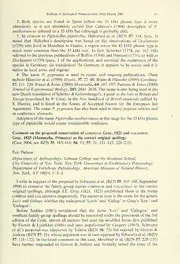
Comment On The Proposed Conservation Of Lorisidae Gray, 1821 And Galagidae Gray, 1825 (Mammalia, Primates) As The Correct Original Spellings PDF
Preview Comment On The Proposed Conservation Of Lorisidae Gray, 1821 And Galagidae Gray, 1825 (Mammalia, Primates) As The Correct Original Spellings
Bulletin ofZoological Nomenclature 58(1) March 2001 61 2. Both species are found in Spain (albeit the 55 kHz phonic type is more abundant), so it not absolutely certain that Cabrera's (1904) description of P. mediterraneus referred to a 55 kHz bat (although it probably did). 3. In relation to Pipistrellus pipistrellus, Helversen et al. (BZN 57: 114, para. 2) noted that 'Schreber's description was based on the observations of Daubenton (1759) who lived in Montbart in France, a region where the 45 kHZ phonic type is much more common than the 55 kHz one'. In fact, Schreber (1774, pp. 167-168) referred to the previous publications ofBuffon (1760) and Pennant (1771), as well as Daubenton (1759) (para. 1 of the application), and recorded the occurrence of the species in Germany: (in translation) 'In Germany it appears to be scarce and it is native in local areas and regions'. 4. The name P. pygmaeus is used in recent and ongoing publications. These include Haussler et al. (1999) Myotis, 37: 27^0; Braun & Haussler (1999) Carolinea, 57: 111-120; Russo & Jones (2000) Mammalia, 64: 187-197; Parsons & Jones (2000) JournalofExperimentalBiology, 203: 2641-2656. The name is also being used in the new Dutch translation ofSchober& Grimmberger's A guide to thebatsofBritainand Europe (translated by P. Lina), in the New handbook ofBritish mammals (edited by S. Harris), and is listed in the Annex of Accepted Names for the European Bat Agreement. The name P. pygmaeus has also been used in many popular articles and in conference abstracts. Adoption ofthename Pipistrellusmediterraneusatthis stageforthe 55 kHzphonic type ofpipistrelle would create considerable confusion. Comment on the proposed conservation of lorisidae Gray, 1821 and galagidae Gray, 1825 (Mammalia, Primates) as the correct original spellings (Case 3004; see BZN 55: 165-168; 56: 73; 57: 51, 121-123, 228-231) Eric Delson Department ofAnthropology, Lehman College and the Graduate School, City University ofNew York; New York Consortium in Evolutionary Primatology; Department of Vertebrate Paleontology, American Museum ofNatural History, New York, NY 10024, U.S.A. I write in support ofthe proposal by Schwartzet al. (BZN55: 165-168, September 1998) to conserve the family-group names lorisidae and galagidae as the correct original spellings, although J.E. Gray (1821, 1825) established them in the forms loridae and galagoninarespectively. Thematterat issue is the stems forthe genera Loris and Galago: whether the widespread 'Loris-' and 'Galag-' or Gray's 'Lor-' and 'Galagon-'. Before Jenkins (1987) considered that the stems 'Lor-' and 'Galagon-' and resultant family-group spellings should be reinstated under the provisions ofthe 3rd edition ofthe Code, almost all authors had used the modified forms first published by Flower & Lydekker (1891) and later popularized by Gregory (1915). Schwartz et al.'s proposal was supported by Yalden (BZN 56: 73) but rejected by Groves & Jenkins (BZN 57: 51), whose argumentwas in turn opposed by Schwartz et al. (BZN 57: 121-122). In the latest comment on this case, Mowbray et al. (BZN 57: 228-231) have further responded to Groves & Jenkins and formally raised the issue of the 62 Bulletin ofZoological Nomenclature 58(1) March 2001 spellings indridae vs. indriidae (based on the genus Indri E. Geoffroy Saint-Hilaire, 1796), to which Groves & Jenkins's comment briefly alluded. Article 29.3.3 (previously 29b(ii)) ofthe Code states that a generic name which is notGreek or Latin takes the stemadoptedbythe authorofanew family-groupname based on that genus. However, in the 4th edition ofthe Code a new provision bears strongly on thiscase: Article 29.5 notesthat 'Ifa spellingofa family-group namewas not formed in accordance with Article 29.3 but is in prevailing usage, that spelling is to be maintained, whether or not it is the original spelling and whether or not its derivation from the name of the type genus is in accordance with the grammatical procedures in Articles 29.3.1 and 29.3.2'. Itisclearthathadthisnewprovision beenineffectin 1987, Jenkinswouldnothave made the proposal to reinstate Gray's original spellings. Even now, as shown by Schwartz et al. in their comment, recent authoritative works have continued to employ the widespread emended spellings lorisidae and galagidae, which are 'in prevailing usage' in the sense ofArticle 29.5 and the Code Glossary. Groves & Jenkins (BZN 57: 51), standing against the Schwartz et al. proposals, noted that the name indriidae Burnett, 1828 also requires alteration to indridae, as originally published. Mowbray et al. (BZN 57: 228-230) have reviewed the history of this name in greater detail and argued for the retention of the prevailing spelling indriidae. In fact, Article 29.5 would apply here as well. Atleast one additionalprimatefamily-groupnamefallsunderthe sameprovisions. Gray (1825) named the family-group taxon Tarsina, based upon Tarsius Storr, 1780. Burnett (1828) modified this to tarsidae, and it was only Gill (1872) who proposed the spelling tarsiidae, which is in prevailing usage today. Yet Jenkins (1987) employed the latter spelling in the same volume in which she altered lorisidae to loridae, galagidae to galagonidae, and indriidae to indridae. To return the question put by Groves & Jenkins to Schwartz et al., why did Groves & Jenkins not question the spelling oftarsiidae in addition to the other three family-group names? Fortunately they did not do so. The Commission is requested to rule in favor of the proposals put forward by Schwartz et al. and by Mowbray et al. Additional reference Gill, T. 1872. Arrangement of the families of mammals with analytical tables. Smithsonian Miscellaneous Collections, 11(1): 1-98.
